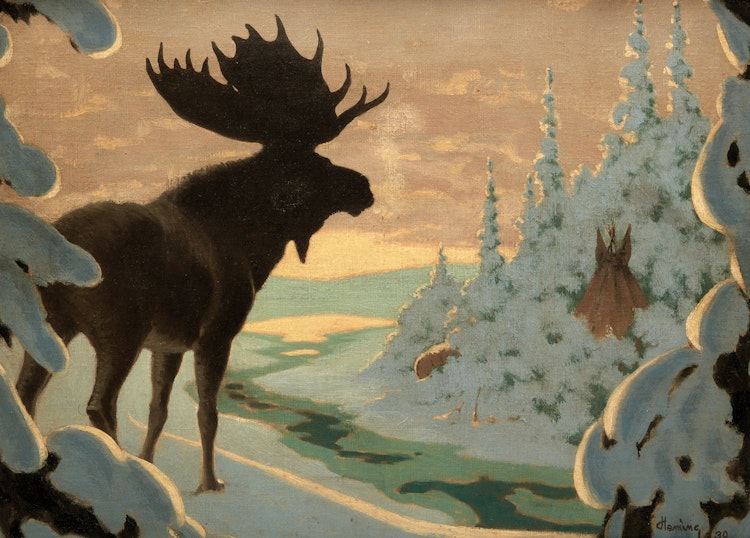The Hunter’s Camp by Arthur Henry Howard Heming

Arthur Heming
The Hunter’s Camp
oil on canvas on board
signed and dated 1930 lower right; titled on partial exhibition label on the reverse
14.75 x 20 in ( 37.5 x 50.8 cm )
Auction Estimate: $8,000.00 - $10,000.00
Price Realized $22,800.00
Sale date: May 30th 2024
Acquired directly from the Artist
By descent to the present Private Collection, Ontario
"Catalogue of the Arts", Canadian National Exhibition, Toronto, 28 August-12 September 1931
Arthur Heming, "Drama of the Forests", Toronto, 1921, similar work reproduced page 133
Cassandra Getty, "Arthur Heming, Chronicler of the North, London", 2013, similar work reproduced page 57
"The Hunter’s Camp" draws the viewers in to admire the thrill of the hunt from the eyes of the hunter. Posed from the brush behind, the hunter both stalks and admires the beauty of this giant, enigmatically Canadian creature. "The Hunter’s Camp" subtle hues of whites and yellows surround the bulk of the large brown moose. Heavy snow layers the trees and hills in the surrounding landscape. The top of a tepee is seen protruding from behind the brush. We are caught in a quiet moment for both the hunter and the hunted.
"The Hunter’s Camp", 1919 (oil on canvas) was purchased by the Royal Ontario Museum of Zoology in 1922. This work, acquired directly from the artist, was displayed at the Canadian National Exhibition in 1931 and is a later re-working of the canvas in the collection of the ROM.
Share this item with your friends
Arthur Henry Howard Heming
(1870 - 1940)
Born in Paris, Ontario, Heming moved with family to Hamilton, Ontario when he was 12. Heming had dreams of becoming an artist and traveller, a dream which led to his study in the evenings at the Hamilton Art School. There at age of 16 he was appointed assistant to the Master where he continued to teach for 16 years (1887-1890). His search for physical challenge led him into the field of sports where he excelled. Heming played lacrosse, football and was a champion at cross-country running.
He started his trips to the wilderness at the age of 16. About 1890 he became a free lance illustrator and submitted many ‘chalk drawings’ to the Hamilton Spectator. Later he made a snowshoe trip to the Temiskaming area where he got material for a series of illustrations on Iroquois Indians for Harper’s Weekly. By 1899 Heming was in New York City where he studied at the Art Student’s League under Frank Vincent Dumond. By 1904 Heming was in London, England, where he studied under Frank Brangwyn who was a noted muralist and etcher. While attending one of his art classes in Canada or the United States, Heming was told that he was partially colour blind. Fearing he would make wrong colour judgments he worked in black, white and yellow until he was sixty years old. It was then that he learned through his artist friend Richard Jack, R.A., that he was no longer colour blind.
His illustrations adorned the pages of many publications of the world and he was hailed for this internationally. His first book “Spirit Lake” was published in 1907. The book deals with the era of the Hudson Bay Company when the wilderness was the free realm of the Indian, and the Indian’s life is very much revealed in the book. By 1910 Heming was back in Toronto, though he moved and travelled frequently in Canada and the U.S. He was one of the first artists to occupy the Studio Building in Toronto built by Lawren S. Harris and Dr. James MacCallum in 1914. Heming held a solo show in Toronto in 1920 and the following year ten of his paintings were purchased by the Royal Ontario Museum.
Heming’s last book “The Living Forest” was published in 1925 when it also appeared in serial form in ‘Mclean’s Magazine’. W. J. Phillips in his article on Heming explained how he moved into colour, “Heming painted pictures in colour for exactly ten years. Prior to that he worked in black and white and yellow. ‘The Living Forest’ is illustrated with pictures done in this technique. Very charming they are, with the decorative quality of a Japanese print. His first picture in colour was ’To Dance the New Year In’. During the course of his career Heming’s were reproduced in international illustrated periodicals including ‘Illustrated London News’, ‘Le Monde Illustré’, ‘New York Times Magazine’ and ‘Berliner Illustrate Zeitung’. A solo show of his paintings was held in London, England at the gallery of Messrs. Frost & Reed, Ltd. The exhibition was a triumph as were his magazine illustrations.
Heming was elected an Associate of the Royal Canadian Academy in 1934. He gave up painting in 1940 because of a sudden failure of the muscles of his hands. Nine months after he stopped painting he passed away in Hamilton, Ontario. He had been working on his fourth book.
Source: "A Dictionary of Canadian Artists, Volume II”, compiled by Colin S. MacDonald, Canadian Paperbacks Publishing Ltd, Ottawa, 1979

